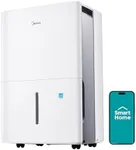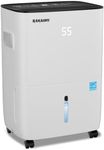Buying Guide for the Best Dehumidifier
Choosing the right dehumidifier can make a big difference in your comfort and the health of your home. Dehumidifiers help remove excess moisture from the air, which can prevent mold, reduce allergens, and protect your belongings. To find the best fit, you should consider the size of the space you want to dehumidify, how damp the area is, and any special features that might make your life easier. Understanding the key specifications will help you match a dehumidifier to your needs and ensure you get the most effective and efficient performance.Capacity (Pints per Day)Capacity refers to how much moisture a dehumidifier can remove from the air in a 24-hour period, usually measured in pints. This is important because it tells you how powerful the unit is and what size space it can handle. Smaller units (20-30 pints) are best for small rooms or mildly damp areas, medium units (30-50 pints) work well for medium-sized rooms or moderately damp spaces, and larger units (50+ pints) are designed for basements, large rooms, or very damp environments. To pick the right capacity, think about the size of your space and how wet it gets—bigger, wetter spaces need higher capacity.
Coverage AreaCoverage area tells you the maximum size of the room or area the dehumidifier is designed to handle, usually given in square feet. This is important because using a unit that's too small for your space won't effectively reduce humidity. Coverage is often divided into small (up to 300 sq. ft.), medium (300-700 sq. ft.), and large (over 700 sq. ft.) spaces. Measure your room and choose a dehumidifier that matches or slightly exceeds your area for best results.
Water Tank SizeThe water tank size is how much water the dehumidifier can hold before it needs to be emptied. A larger tank means you won't have to empty it as often, which is convenient if you plan to run the unit continuously. Tanks can range from about 1 to 2 gallons for smaller units to 3 gallons or more for larger ones. If you don't want to empty the tank frequently, look for a bigger tank or a model with a continuous drain option.
Drainage OptionsDrainage options refer to how the dehumidifier gets rid of the collected water. Some units require you to manually empty the tank, while others offer a hose connection for continuous drainage. This is important if you want low maintenance or plan to use the dehumidifier in a place where emptying the tank often would be inconvenient. If you want to set it and forget it, look for a model with a built-in pump or gravity drain option.
Humidistat and ControlsA humidistat lets you set your desired humidity level, and the dehumidifier will automatically turn on or off to maintain it. This is important for comfort and energy savings, as it prevents the unit from running unnecessarily. Some models have simple dial controls, while others offer digital displays and precise settings. If you want more control and convenience, look for a model with an adjustable humidistat and easy-to-use controls.
Noise LevelNoise level tells you how loud the dehumidifier is when running, usually measured in decibels (dB). This matters if you plan to use the unit in a bedroom, living room, or office where quiet is important. Lower noise levels (below 50 dB) are best for quiet spaces, while higher levels may be fine for basements or garages. Consider where you'll use the dehumidifier and choose a noise level that won't disturb you.
Energy EfficiencyEnergy efficiency shows how much electricity the dehumidifier uses to remove moisture. More efficient models save you money on your energy bills and are better for the environment. Look for units with an Energy Star rating or similar certification, which means they meet certain efficiency standards. If you plan to run your dehumidifier often or for long periods, choosing an efficient model will help keep costs down.
Filter Type and MaintenanceDehumidifiers often have filters to trap dust and allergens, helping to clean the air as they remove moisture. The type and ease of cleaning or replacing the filter is important for ongoing performance and air quality. Some filters are washable, while others need to be replaced regularly. If you want less hassle, look for a model with an easy-to-access, washable filter.















